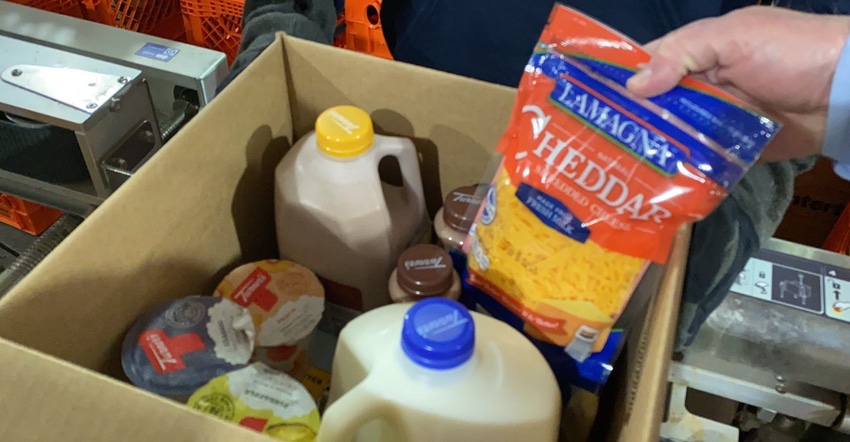
Although many celebrated the downward trends in food insecurity in the decade leading up to 2020, without question the pandemic catapulted more families into food insecurity, shared Eric Hodel, chief operating and chief financial officer for the Midwest Food Bank in Normal, Illinois, during a House Agriculture Committee hearing on food insecurity March 11.
Midwest Food Bank helped distribute over 1 million boxes in 2020 through the Farmers to Families Food Box program which he says, “injected nutrition directly into the emergency food system while supporting farmers and producers.”
Prior to the pandemic, in February of 2020, there were 36.8 million people on Supplemental Nutrition Assistance Program. By April of 2020, SNAP rolls were up to 40 million people and that increased to nearly 43 million people by September of last year, shares House Agriculture Committee Chairman David Scott, D-Ga.
And the future looks to continue with increased needs. The Congressional Budget Office in February released their baseline projections for the next 10 years for SNAP. “They predict that the negative effects of the pandemic will continue through most of 2022, with an average total of 44 million people on SNAP next year, before it begins to decrease in 2023,” Scott shares.
Ron Edenfield, president of Wayfield Foods, a nine-store independent grocer with stores across the metro-Atlanta area, testified that the food boxes offered a short-term solution, but long-term solutions are needed.
“While I certainly believe the need is there and that we should do everything we can do help these families, I know without a doubt that the existing food partnerships that distribute funds through an [Electronic Benefits Transfer] EBT card or through food banks are far more efficient and give parents the opportunity to shop at their convenience and to purchase the best foods for their children.”
Future of food boxes
No decision has been made yet on whether to extend the food box program which delivered over 140 million food boxes in 2020 after the pandemic hit. In mid-February, USDA’s Agricultural Marketing Service informed contract holders that it will continue to administer contracts for the food box program through April 2021 as originally intended when round five was announced in January by the outgoing Trump administration.
A total of $1.5 billion was made available in December in the COVID relief package to cover commodity purchases and other needs. A statement from Matt Herrick, USDA spokesman, says USDA will disburse all of that funding by the end of April or soon thereafter.
The appropriations law passed in December 2020 also requested USDA to assess commodity purchase programs including this one in response to the pandemic, and USDA says it has begun that process.
During a National Press Club event on hunger, Secretary of Agriculture Tom Vilsack notes that the food box program offered important access to food and helped divert food to new avenues, but USDA also recognizes there are some concerns with unequal cost distribution for the filling of these boxes.
Vilsack says USDA is evaluating the program to determine if the agency will continue something similar to what was created in 2020, or something smaller or more focused. He says the question is how USDA may preserve what may have worked well with the Farmers to Families Food Box program and assure resources redirected under The Emergency Food Assistance Program distribution system could possibly more effectively provide assistance and help to more people.
Through TEFAP, USDA purchases a variety of nutritious, high-quality USDA foods, and makes those foods available to state distributing agencies. Vilsack hopes to utilize that highly efficient distribution system under TEFAP and preserve what worked under the food box program.
On March 8, the National Association of State Departments of Agriculture sent a letter to Vilsack in support of the Farmers to Families Food Box program and recommended adjustments to improve the program’s effectiveness. Recommendations included increasing the variety of meat products by removing the current restriction that limits products to only pre‐cooked meats. Other suggestions include considering the adverse impact on smaller farms when awarding contracts based on price, enabling vendors to curate boxes based on local preference and availability of food, and encouraging the participation of socially disadvantaged farmers.
“Gathering feedback is very important. The food box effort served some communities well, but faced challenges in others, and so as part of our assessment, we are gathering feedback from distributors, nonprofits, and other stakeholders in rural and urban areas to learn what worked and didn’t. We want to know if pieces of the program can be preserved or redesigned moving forward and we’re gathering feedback now to make that decision,” Herrick says.
“If the program continues beyond April, it is likely to look different, but the intent to use our resources to address market disruption and reach individuals and communities in need and to do so equitably, will remain a priority,” Herrick adds.
During the NPC event, Vilsack says the food box program did provide access to healthy, nutritious food in all of the country with the requirement to have dairy, fresh fruits and vegetable and meat in each box. He also noted that it’s important for USDA to address not only food security, but nutrition security.
“We need a concerned effort to not simply focus on hunger, but recognizing we also have a nutrition challenge. We need to solve both of them,” Vilsack says.
Read more about:
Farmers To Families Food BoxAbout the Author(s)
You May Also Like






